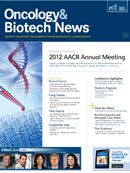Publication
Article
Oncology & Biotech News
Older Lung Cancer Patients Do Not Benefit From Bevacizumab Added to Standard Treatment
Author(s):
The addition of bevacizumab to first-line carboplatin-paclitaxel did not prolong survival in Medicare recipients with advanced non–small cell lung cancer.
Deborah Schrag, MD, MPH
The addition of bevacizumab (Avastin) to first-line carboplatin-paclitaxel did not prolong survival in Medicare recipients with advanced non—small cell lung cancer (NSCLC), new data show.
Deborah Schrag, MD, MPH, from Dana-Farber Cancer Institute and Harvard Medical School in Boston, Massachusetts, and associates compared survival outcomes for patients who were treated with conventional carboplatin and paclitaxel chemotherapy with or without bevacizumab.
About two-thirds of lung cancer patients are diagnosed with the disease at age 65 or older, Schrag et al pointed out. Thus, it is important to determine bevacizumab’s effect on survival in this population in order to make informed treatment decisions.
The study included 4168 Medicare recipients aged 65 years or older with stage IIIB or IV nonsquamous cell NSCLC who were diagnosed between 2002-2007 in a Surveillance, Epidemiology, and End Results (SEER) region. The SEER database records cancer incidence for nearly a third of the US population and compiles information on cancer site, histology, stage, grade, dates of diagnosis and death, and patient demographic characteristics.
Patients were divided into three groups based on the year of diagnosis and type of initial chemotherapy administered within 4 months of their diagnosis: (1) diagnosis in 2006-2007 and bevacizumab-carboplatin-paclitaxel therapy; (2) diagnosis in 2006-2007 and carboplatin-paclitaxel therapy; or (3) diagnosis in 2002-2005 and carboplatin-paclitaxel therapy.
Results showed that the median overall survival was 9.7 months (interquartile range [IQR], 4.4-18.6) for patients receiving the triple-drug combination versus 8.9 months (IQR, 3.5-19.3) for the 2006-2007 standard-therapy group, and 8.0 months (IQR, 3.7-17.2) for the 2002-2005 standard-therapy group. The probability of surviving for one year was 39.6% (95% CI, 34.6%-45.4%) for patients who received the three drugs versus 40.1% (95% CI, 37.4%-43.0%) for the 2006-2007 standard-therapy group, and 35.6% (95% CI, 33.8%-37.5%) for the 2002-2005 standard-therapy group.
The study also found no evidence that bevacizumab produced a survival advantage in multivariate models that adjusted for demographic and clinical patient characteristics.
In addition, the data showed that bevacizumab was not universally adopted after the FDA approved its use in combination with carboplatin and paclitaxel for the treatment of advanced NSCLC in 2006. In fact, only 20% of patients in the analysis who were diagnosed with lung cancer in 2006 and 22% of patients who were diagnosed in 2007 received bevacizumab as a component of their first-line carboplatin-paclitaxel chemotherapy.
The authors cautioned that their study may have limitations typical of all observational studies, as well as studies that use administrative data sources such as Medicare. For example, the study included only Medicare fee-for-service beneficiaries who were aged 65 years or older and residing in a SEER region at the time of the diagnosis, a population that does not necessarily represent all patients with nonsquamous cell NSCLC in the United States. In addition, SEER Medicare does not have clinical information such as the presence of molecular biomarkers, performance status, and baseline pulmonary function. Such information may have an impact on the selection of chemotherapy drugs, survival, or both.
Zhu J, Sharma DB, Gray SW, Chen AB, Weeks JC, Schrag D. Carboplatin and paclitaxel with vs without bevacizumab in older patients with advanced non—small cell lung cancer. JAMA. 2012;307(15):1593-1601.






%20(2)%201-Recovered-Recovered-Recovered-Recovered-Recovered.jpg?fit=crop&auto=format)

%20(2)%201-Recovered-Recovered-Recovered-Recovered-Recovered.jpg?fit=crop&auto=format)
%20(2)%201-Recovered-Recovered-Recovered-Recovered-Recovered.jpg?fit=crop&auto=format)